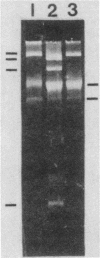Abstract
We examined a group of 23 recent clinical isolates of Yersinia enterocolitica recovered from symptomatic patients residing in the New York, N.Y. area. These isolates were tested for the presence of plasmids, exoenzyme activity, mouse lethality, and phenotypic properties postulated to correlate with virulence. Of the 23 isolates, 17 harbored a 60- to 65-kilobase (kb) plasmid. Six isolates were lethal for white mice, showed the phenotypic markers of autoagglutination and calcium dependence for growth at 37 degrees C, and contained a 60- to 65-kb plasmid. Restriction endonuclease analysis with several different enzymes revealed the presence of three distinct plasmid profiles in these isolates. Isolates with a single plasmid of 60 to 70 kb, typical for this species, were detected, but these were of three distinct types as judged from restriction enzyme digestion. One strain was unusual among clinical isolates of Y. enterocolitica in that it contained at least four distinct plasmids. In addition, this nontypable strain showed exoenzymatic activity similar to that of serogroup O8 isolates, was not lethal to mice, and did not require calcium for growth at 37 degrees C.
Full text
PDF


Images in this article
Selected References
These references are in PubMed. This may not be the complete list of references from this article.
- Bölin I., Norlander L., Wolf-Watz H. Temperature-inducible outer membrane protein of Yersinia pseudotuberculosis and Yersinia enterocolitica is associated with the virulence plasmid. Infect Immun. 1982 Aug;37(2):506–512. doi: 10.1128/iai.37.2.506-512.1982. [DOI] [PMC free article] [PubMed] [Google Scholar]
- Carter P. B., Zahorchak R. J., Brubaker R. R. Plague virulence antigens from Yersinia enterocolitica. Infect Immun. 1980 May;28(2):638–640. doi: 10.1128/iai.28.2.638-640.1980. [DOI] [PMC free article] [PubMed] [Google Scholar]
- Gemski P., Lazere J. R., Casey T. Plasmid associated with pathogenicity and calcium dependency of Yersinia enterocolitica. Infect Immun. 1980 Feb;27(2):682–685. doi: 10.1128/iai.27.2.682-685.1980. [DOI] [PMC free article] [PubMed] [Google Scholar]
- Gray J. E., Patin D. W., Calhoun D. H. Identification of the protein products of the rrnC, ilv, rho region of the Escherichia coli K-12 chromosome. Mol Gen Genet. 1981;183(3):428–436. doi: 10.1007/BF00268761. [DOI] [PubMed] [Google Scholar]
- Greene P. J., Heyneker H. L., Bolivar F., Rodriguez R. L., Betlach M. C., Covarrubias A. A., Backman K., Russel D. J., Tait R., Boyer H. W. A general method for the purification of restriction enzymes. Nucleic Acids Res. 1978 Jul;5(7):2373–2380. doi: 10.1093/nar/5.7.2373. [DOI] [PMC free article] [PubMed] [Google Scholar]
- HIGUCHI K., SMITH J. L. Studies on the nutrition and physiology of Pasteurella pestis. VI. A differential plating medium for the estimation of the mutation rate to avirulence. J Bacteriol. 1961 Apr;81:605–608. doi: 10.1128/jb.81.4.605-608.1961. [DOI] [PMC free article] [PubMed] [Google Scholar]
- Janda J. M., Bottone E. J. Pseudomonas aeruginosa enzyme profiling: predictor of potential invasiveness and use as an epidemiological tool. J Clin Microbiol. 1981 Jul;14(1):55–60. doi: 10.1128/jcm.14.1.55-60.1981. [DOI] [PMC free article] [PubMed] [Google Scholar]
- Kay B. A., Wachsmuth K., Gemski P., Feeley J. C., Quan T. J., Brenner D. J. Virulence and phenotypic characterization of Yersinia enterocolitica isolated from humans in the United States. J Clin Microbiol. 1983 Jan;17(1):128–138. doi: 10.1128/jcm.17.1.128-138.1983. [DOI] [PMC free article] [PubMed] [Google Scholar]
- Kay B. A., Wachsmuth K., Gemski P. New virulence-associated plasmid in Yersinia enterocolitica. J Clin Microbiol. 1982 Jun;15(6):1161–1163. doi: 10.1128/jcm.15.6.1161-1163.1982. [DOI] [PMC free article] [PubMed] [Google Scholar]
- Laird W. J., Cavanaugh D. C. Correlation of autoagglutination and virulence of yersiniae. J Clin Microbiol. 1980 Apr;11(4):430–432. doi: 10.1128/jcm.11.4.430-432.1980. [DOI] [PMC free article] [PubMed] [Google Scholar]
- Portnoy D. A., Moseley S. L., Falkow S. Characterization of plasmids and plasmid-associated determinants of Yersinia enterocolitica pathogenesis. Infect Immun. 1981 Feb;31(2):775–782. doi: 10.1128/iai.31.2.775-782.1981. [DOI] [PMC free article] [PubMed] [Google Scholar]
- Schiemann D. A., Devenish J. A., Toma S. Characteristics of virulence in human isolates of Yersinia enterocolitica. Infect Immun. 1981 Apr;32(1):400–403. doi: 10.1128/iai.32.1.400-403.1981. [DOI] [PMC free article] [PubMed] [Google Scholar]
- Vesikari T., Sundqvist C., Mäki M. Adherence and toxicity of Yersinia enterocolitica 0:3 and 0:9 containing virulence-associated plasmids for various cultured cells. Acta Pathol Microbiol Immunol Scand B. 1983 Apr;91(2):121–127. doi: 10.1111/j.1699-0463.1983.tb00020.x. [DOI] [PubMed] [Google Scholar]
- Wachsmuth K., Kay B. A., Birkness K. A. Diagnostic value of plasmid analyses and assays for virulence in Yersinia enterocolitica. Diagn Microbiol Infect Dis. 1984 Jun;2(3):219–228. doi: 10.1016/0732-8893(84)90034-8. [DOI] [PubMed] [Google Scholar]
- Zink D. L., Feeley J. C., Wells J. G., Vanderzant C., Vickery J. C., Roof W. D., O'Donovan G. A. Plasmid-mediated tissue invasiveness in Yersinia enterocolitica. Nature. 1980 Jan 10;283(5743):224–226. doi: 10.1038/283224a0. [DOI] [PubMed] [Google Scholar]




